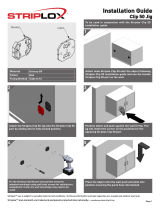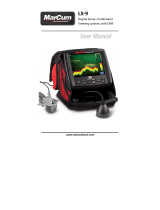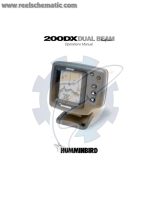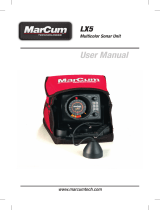
ICE 35, ICE 45, ICE 55
Installation and Operations Manual
531611-1_C

ii
THANK YOU!
Thank you for choosing Humminbird®, America's #1 name in fishfinders. Humminbird®
has built its reputation by designing and manufacturing top-quality, thoroughly reliable
marine equipment.
Your Humminbird® is designed for trouble-free use in even the harshest marine
environment. In the unlikely event that your Humminbird® does require repairs, we offer
an exclusive Service Policy - free of charge during the first two years after purchase, and
available at a reasonable rate after the two-year period. For complete details, see the
Warranty section included in this manual.
We encourage you to read this installation and operations manual carefully in order to
get full benefit from all the features and applications of your Humminbird® product.
Contact our Customer Resource Center at either 1-800-633-1468 or visit our website
at www.humminbird.com.
WARNING! Do not touch an active transducer during operation, as this may cause
physical discomfort and may result in personal injury in the form of tissue damage. Handle
the transducer only when the power to the fishfinder is off.
WARNING! This device should not be used as a navigational aid to prevent collision,
grounding, boat damage, or personal injury. When the boat is moving, water depth may
change too quickly to allow time for you to react. Always operate the boat at very slow
speeds if you suspect shallow water or submerged objects.
WARNING! Disassembly and repair of this electronic unit should only be performed by
authorized service personnel. Any modification of the serial number or attempt to repair
the original equipment or accessories by unauthorized individuals will void the warranty.
WARNING! This product contains chemicals known to the State of California to cause
cancer and/or reproductive harm.
Humminbird® and ICE Flasher Series™ are trademarked by or registered trademarks of Humminbird®.
© 2008 Humminbird®, Eufaula AL, USA. All rights reserved.

iii
TABLE OF CONTENTS
How Sonar Works 1
How Ice Flashers Work 4
Installation Overview 5
ICE Flasher Series™ Base Assembly 6
1. Assembling the Transducer Storage Posts .............................................................. 6
2. Assembling the Base and Handle............................................................................ 7
3. Assembling the Control Head to the Base and Handle.......................................... 8
ICE Flasher Series™ Assembly 9
1. Connecting the Power Cable .................................................................................... 9
2. Charging and Installing the Battery ........................................................................ 9
3. Assembling the Portable Bag (ICE 45/55 Only) ......................................................11
Transducer Installation 12
1. Testing the Transducer Prior to Installation............................................................12
2. Assembling the Transducer and Float ....................................................................12
3. Connecting the Transducer Cable ..........................................................................14
4. Storing the Transducer ............................................................................................15
Test and Finish the Installation 16
Getting Started - Using Your ICE Flasher Series™ Fishfinder 17
Powering Up the Control Head....................................................................................18
Simulator........................................................................................................................18
What’s on the Flasher Dial ..........................................................................................18
What’s on the Display ................................................................................................ 20
Key Functions 20
Power/Range Dial........................................................................................................ 21
Selection Dial .............................................................................................................. 22
Zoom ............................................................................................................................ 23

iv
Gain .............................................................................................................................. 24
Noise Rejection............................................................................................................ 25
Beam ............................................................................................................................ 26
Color (ICE 55 Only) ...................................................................................................... 27
Palette 1 (ICE 35/45/55).......................................................................................... 27
Palette 2 (ICE 55 Only) ............................................................................................ 28
Palette 3 (ICE 55 Only) ............................................................................................ 29
Target (ICE 55 Only) .................................................................................................... 30
Dual Mode Key Functions .......................................................................................... 31
Maintenance 32
ICE Flasher Series™ Maintenance ............................................................................ 32
Transducer Maintenance ............................................................................................ 32
Troubleshooting 33
ICE Flasher Series™ Fishfinder Doesn't Power Up.................................................... 33
No Bottom Reading on the Display............................................................................ 33
No Continuous Depth Display in Very Shallow Water.............................................. 33
Screen Fades, Images are Not Sharp ........................................................................ 33
2-Year Limited Warranty 34
Humminbird® Service Policy 35
Returning Your Unit for Service.................................................................................. 36
Specifications 37
Contact Humminbird® 40
NOTE: Some features discussed in this manual require a separate purchase, and some
features are only available on certain models. Please read the manual carefully in order to
understand the full capabilities of your model. You can visit our website at
www.humminbird.com to order accessories online or contact our Customer Resource
Center at 1-800-633-1468.

1
HOW SONAR WORKS
Sonar technology is based on sound waves. The ICE Flasher Series™ Fishfinder uses
sonar to locate structure, bottom composition, as well as depth directly below the
transducer. Your ICE Flasher Series™ Fishfinder consists of two components: the control
head and the transducer. The control head contains the transmitter and receiver, as well
as the user controls and display. The transducer is suspended beneath the water,
underneath the ice, and converts electrical energy from the transmitter into mechanical
pulses or sound waves. The transducer also receives the reflected sound waves and
converts them back into electrical signals for display on the Flasher Dial.
NOTE: The transducer must be submerged in water for reliable transducer detection. The
bottom of the transducer should be even with the bottom of the ice or hang slightly below
the bottom of the ice.
Your ICE Flasher Series™ Fishfinder sends a sound wave signal and determines distance
by measuring the time between the transmission of the sound wave and when the
sound wave is reflected off of an object; it then uses the reflected signal to interpret
depth, size, and composition of an object.
Sonar is very fast. A sound wave can travel from the surface to a depth of 240 ft (70 m)
and back again in less than 1/4 of a second.
SONAR is an acronym for SOund and
NAvigation Ranging. Sonar utilizes precision
sound pulses or “pings” which are emitted
into the water in a teardrop-shaped beam.
The sound pulses “echo” back from objects
in the water such as the bottom, fish and
other submerged objects. The returned
echoes, or signals, are displayed as colored
lines on the Flasher Dial.
Real Time Sonar
Instant Display

When all the echoes are viewed within
the beam, an easy to interpret multicolor
palette of sonar return signals appears
on the Flasher Dial. The ICE Flasher
Series™ Fishfinder plots the depth and
intensity of sonar returns from the
bottom, fish and structure.
The sound pulses are transmitted at
various frequencies depending on the
application. Your ICE Flasher Series™
Fishfinder gives you the power to choose
the frequency and coverage of your
sonar. 455 kHz provides narrow coverage
with the greatest definition. 240 kHz
provides wider coverage and a good
balance between depth performance
and resolution.
The power output is the amount of energy
generated by the sonar transmitter. It is
commonly measured using two methods:
• Root Mean Square (RMS) measures
power output over the entire transmit
cycle.
• Peak to Peak measures power output
at the highest points. The benefits of
increased power output are the ability
to detect smaller targets at greater
distances, ability to overcome noise,
and enhanced depth capability.
2

Your ICE Flasher Series™ Fishfinder uses
selectable dual-frequency sonar with a wide
area of coverage. Selectable dual-frequency
gives you the option of two beams, and both
beams will cover the bottom and provide high
definition. The 9 degree center beam provides
the highest definition, while the 19 degree beam
provides wider coverage. Depth capability is
affected by such factors as bottom hardness,
water conditions, and transducer installation.
Whether fishing in shallow to very deep water,
in both fresh and salt water, selectable
dual-frequency is ideal for a variety of conditions.
3

HOW ICE FLASHERS WORK
Although the sonar part of an ICE Flasher Series™ Fishfinder works in the same way as
any other Humminbird® control head, the return signal is displayed differently. The ICE
Flasher Series™ LCD is modeled on the original analog displays and represents what is
happening below the transducer the moment it happens. The Flasher Dial displays a
multicolor palette indicating low to high sonar intensity returns, where red indicates high
intensity and green indicates low intensity. See Color Palettes for more information.
When fish swim into the area below the transducer, the new sonar return signal is
immediately displayed on the Flasher Dial. Depending on the size of the fish and its
closeness to the transducer, the sonar return will be displayed as a weak, medium, or
strong sonar signal.
In the above example, the sonar return signal from the jig is displayed as a weak signal
(green), the fish is displayed as a medium signal (yellow), and the bottom composition
is displayed as a strong signal (red). When the fish swims towards your jig, you can see
the activity instantly on your Flasher Dial. Also, the Active Display shows that the ICE
45/55 Flasher is reading the depth of 18.3 feet to the bottom.
Medium Sonar
Return Signal
(fish)
Weak Sonar Return
Signal (jig)
Read the Flasher Dial
in a Clockwise Direction
Strong Sonar Return
Signal (bottom)
Algae and Other
Surface Vegetation
Close to
Surface of
the Water
Depth Reading
4

INSTALLATION OVERVIEW
Before you start installation, we encourage you to read these instructions carefully
in order to get the full benefit from your ICE Flasher Series™ Fishfinder. You will
assemble your control head first, then assemble and install your transducer. When
you are done with both of these installation tasks, you should perform a final
installation test before operating your ICE Flasher Series™ Fishfinder.
Please make sure that the following parts are included for your ICE Flasher Series™
control head:
• ICE Flasher Series™ control head
• Portable base and handle
• Power cable, battery, battery charger, and connecting hardware
• Flasher Bag (ICE 55 only)
Also, please make sure the following parts are included for your transducer:
• Ice Fishing transducer with 8' of signal cable
• Float, 40" of support cable, and support clip
• Cable clamps.
In addition to the hardware supplied, you will need a Phillips-head and a flat-head
screwdriver for installation and operation.
5

ICE FLASHER SERIES™ BASE ASSEMBLY
Perform the following high-level steps by following the instructions in each numbered
section to assemble the ICE Flasher Series™ base assembly:
1. Assembling the transducer storage posts
2. Assembling the base and handle
3. Assembling the control head to the base and handle
1.
Assembling the Transducer Storage Posts
In this procedure you will install the posts to hold the transducer cable.
1. Slide one spring over each flat-head screw and set aside.
2. Insert a nut into the keyed space of each cable retention arm. Push down on the
nut until it is flush with the surface of the cable retention arm.
3. Slide one cable retention arm over one storage post so that the arm faces out.
4. Hold the cable retention arm in place, and turn the base upside down.
5. Drop the assembled screw and spring straight into the back of the storage post.
Using a flat-head screwdriver, push down on the screw, and tighten.
6. Repeat steps 2-5 for the second cable retention arm.
Nut
Keyed Space of
Cable Retention Arm
Storage Post
Cable Retention
Arm, facing out
Spring
Flat Head Screw
6

2.
Assembling the Base and Handle
In this procedure, you will install the handle onto the base, and attach the tie-down
straps that will be used to secure the battery to the base in a later procedure.
1. Install the handle onto the base, so that the curved part of the handle faces
towards the back of the base, towards the battery well. Use the four included
#8-32 x 7/16" screws, two on each side, to attach the handle to the base (see the
illustrations Installing the Handle Onto the Base and Sliding in the Handle).
Hand tighten only!
NOTE: The handle is keyed so that it only fits onto the base in one direction.
2. Turn the base upside down, then thread the two included battery tie-down straps
from the bottom of the base up through each side of the battery well, using the
strap holes (see the illustration Attaching the Battery Tie-Down Straps).
Attaching the Battery Tie-Down Straps
Battery
Tie-down Straps
Sliding in the Handle
Installing the Handle Onto the Base
7

3.
Assembling the Control Head to the Base and Handle
In this procedure you will install the ICE Flasher Series™ control head to the
base/handle assembly.
1. Place the control head into the gimbal bracket located on the base.
2. Place the 1" diameter black washers as shown in the figure; then, thread the
gimbal knob through the bracket and washers, into the housing. Tighten the
gimbal knob to secure the ICE Flasher Series™ control head to the mount.
3. Repeat step 2 for the other side.
Base Arm
Knob
Washer
Washer
8

ICE FLASHER SERIES™ ASSEMBLY
In this procedure you will connect the power cable to the control head and install the
base/handle assembly into the portable bag.
1.
Connecting the Power Cable
1. Insert the power cable into the back of the control head. The slots for the plugs
are keyed to prevent reverse installation.
2.
Charging and Installing the Battery
1. Charge the battery, using the included battery charger, until it is fully charged.
Charging usually requires 8 continuous hours but may vary depending on your
configuration. The LED on the charger will turn green when the battery is
fully charged.
NOTE: Some international models may not include a battery or battery charger.
NOTE: The battery charger uses a yellow LED to indicate it is charging. On some models,
this light might appear closer to orange than yellow. When this happens, the battery is still
charging properly and should be left to charge until the LED becomes green.
CAUTION: Do not pull on the battery or charger cables when you are trying to connect
them to or disconnect them from the battery terminals. Push or pull gently on the spade
terminals instead. If the connector feels tight, use a slight wiggling motion to slide the
spade connector into place on the terminal.
2. Center the battery on top of the foam pad.
9

3. Move the tie-down straps out of the way so that the battery well is fully accessible.
4. Hold the foam pad and the battery together, and slide them into the battery well.
Make sure that the spade terminals are on the left side of the battery well and
the foam pad fits evenly around the battery well edges.
5. Pull the two battery tie-down straps over the top
of the battery and connect both ends of each
strap over the top. Make sure that the straps
are pulled tight around the battery and that the
battery is seated securely in the battery well.
6. Slide the Battery Terminal Adapter over each
spade terminal.
NOTE: The Battery Terminal Adapter allows you to power
your control head and charge it at the same time.
Installing the Battery Tying Down the Battery
NOTE: Do NOT connect the power cable to the battery at this time. You should
wait until just before fishing to connect the power cable to the battery.
Battery
Foam Pad
Spade
Terminals
10

11
3.
Assembling the Portable Bag (ICE 55 Only)
In this procedure, you will install the ICE 55 Flasher into the portable bag. The portable
bag is not included with ICE 35/45 Flashers.
1. Unzip the largest opening on the front of the portable bag.
2. Insert the base/handle assembly into the portable bag, so that the Flasher Dial is
facing out of the bag. For best results, pull the bag over one shoulder of the
handle at a time.
3. Adjust the bag so that you can easily grab the handle, through the fabric
handhold inset, from the outside top of the portable bag.
Installing the Base
into the Bag
Pulling the Bag
over the Handle
Holding the
Portable Bag

TRANSDUCER INSTALLATION
Perform the following high-level steps by following the instructions in each numbered
section to install the transducer.
1. Testing the transducer
2. Assembling the transducer and float
3. Connecting the cable
1.
Testing the Transducer Prior to Installation
Prior to installation, test the transducer to make sure that no damage occurred during
shipping.
1. Connect the transducer to the control head. The slots are keyed to prevent reverse
installation, so be careful not to force the connector into the holder.
2. Drop the transducer into the ice hole. If the transducer is working properly, you
will see the bottom displayed on the Flasher Dial as a red line.
WARNING: Before walking onto the ice, make sure that conditions are safe.
2.
Assembling the Transducer and Float
In this procedure you will assemble the transducer and float.
1. Thread the support cable through
the support clip and then clip onto
the transducer.
2. Attach your transducer float to the
support cable by sliding the support
cable through the slit in the float.
NOTE: Attaching the float is optional. You
can also use the storage posts to hold the
support cable in position.
Attaching the Float to
the Support Cable
Float
Signal
Cable
Support
Cable
Cable
Support
Clip
Transducer
Support
Cable
Threading Support
Cable through
Support Clip
12

3. Position the float so that the transducer will be submerged in the water, just
below the ice.
NOTE: The transducer must be submerged in water for reliable transducer detection. The
bottom of the transducer should be even with the bottom of the ice or hang slightly below the
bottom of the ice.
4. Once you know where you want to
position your float, place one of the cable
clamps onto the support cable, above the
float. Use the inside, smaller cable hole
for the support cable so that the float will
not move, and so that the transducer will
maintain its position under the ice. Make
sure that the support cable is taut, so that
the transducer hangs straight down (see
illustration).
5. If you would like to keep the support and
signal cables together above the float
stop, attach a cable management clamp
(included) to the support cable (using
the inner, smaller hole) and the signal
cable (using the outer, larger hole).
Make sure that the signal cable has
some slack so that it is not bearing the
weight of the transducer.
Cable Clamp
Signal Cable Hole
Support Cable Hole
Attaching the Cable Clamps
Cable Clamp
(acts as a stop for the
support cable, sets depth
of transducer in ice hole -
see Procedure 2, step 4)
Signal
Cable
Support
Cable
Support
Cable
Cable Clamp
(provides cable
management for
signal cable - see
Procedure 2, step 5)
Signal
Cable
Ice Layer
Float
Transducer
13

3.
Connecting the Transducer Cable
This section covers how to connect your transducer cable to your control head.
NOTE: If you have an ICE 55 Flasher, remove the control head and base from the portable
bag first.
1. Insert the transducer cable into the appropriate terminal slot on the rear of the
control head.
NOTE: The slots are keyed to prevent reversed installation, so be careful not to force the
connector onto the holder.
2. Route the transducer signal cable beneath the control head and secure to cable
clips on the base.
3. Reinstall assembled control head, base, and transducer into portable bag
(ICE 55 only).
Connecting to the ICE Flasher Series™ Fishfinder
Transducer
Signal Cable
Cable
Clips
14

4.
Storing the Transducer
When you are done fishing, store the transducer using the following guidelines:
1. Wipe the cable dry.
2. Tuck the float under the control head, and wrap the cable around the storage
posts. Store the transducer in the transducer well.
NOTE: You do not have to detach the transducer cable from the control head to store
the transducer.
CAUTION: Although the transducer signal cable is designed to be flexible in cold
temperatures, you must store your cable correctly to avoid stressing it. Make sure it is
coiled smoothly, with no kinks, and that it is clear of the zippers on the portable bag.
Storing the Transducer
Cable Wrapped
Around Storage
Posts
Transducer Well
Float Tucked
Under Control
Head
15

TEST AND FINISH THE INSTALLATION
Once you have assembled both the ICE Flasher Series™ control head and the Ice Fishing
transducer, and have routed all the cables, you should perform a final test. Testing
should be performed with the transducer in the water.
1. After connecting the transducer to the control head, and confirming that the
power cable is connected to the battery, drop the transducer into the ice hole to
confirm proper operation.
WARNING: Before walking onto the ice, make sure that conditions are safe.
2. Turn the Power/Range dial to A (Auto) or x1 to power-on the control head.
NOTE: If the unit does not power up, make sure that the connector is fully seated in the
back of the control head, the power cable is connected to the battery, and the battery is
charged.
3. If all connections are correct and power is available, the Humminbird® control
head will enter Normal operation, and you should see the bottom on the control
head display.
4. If the bottom is visible on-screen with a digital depth readout, the unit is working
properly (ICE 35 will only display the bottom on the Flasher Dial).
NOTE: The transducer must be submerged in water for reliable transducer detection. The
bottom of the transducer should be even with the bottom of the ice or hang slightly below
the bottom of the ice.
16
Page is loading ...
Page is loading ...
Page is loading ...
Page is loading ...
Page is loading ...
Page is loading ...
Page is loading ...
Page is loading ...
Page is loading ...
Page is loading ...
Page is loading ...
Page is loading ...
Page is loading ...
Page is loading ...
Page is loading ...
Page is loading ...
Page is loading ...
Page is loading ...
Page is loading ...
Page is loading ...
Page is loading ...
Page is loading ...
Page is loading ...
Page is loading ...
-
 1
1
-
 2
2
-
 3
3
-
 4
4
-
 5
5
-
 6
6
-
 7
7
-
 8
8
-
 9
9
-
 10
10
-
 11
11
-
 12
12
-
 13
13
-
 14
14
-
 15
15
-
 16
16
-
 17
17
-
 18
18
-
 19
19
-
 20
20
-
 21
21
-
 22
22
-
 23
23
-
 24
24
-
 25
25
-
 26
26
-
 27
27
-
 28
28
-
 29
29
-
 30
30
-
 31
31
-
 32
32
-
 33
33
-
 34
34
-
 35
35
-
 36
36
-
 37
37
-
 38
38
-
 39
39
-
 40
40
-
 41
41
-
 42
42
-
 43
43
-
 44
44
Humminbird ICE 55 User manual
- Type
- User manual
- This manual is also suitable for
Ask a question and I''ll find the answer in the document
Finding information in a document is now easier with AI
Related papers
-
Humminbird 345C User manual
-
Humminbird Fishing Equipment User manual
-
Humminbird 385Ci User manual
-
Humminbird 778C User manual
-
Humminbird 778C User manual
-
Humminbird 530508-3_A User manual
-
Humminbird 408930-1 User manual
-
Humminbird 900 User manual
-
Humminbird 409380-1 User manual
-
Humminbird ProFlasher User manual
Other documents
-
 STRIPLOX Clip 50 Connector Installation guide
STRIPLOX Clip 50 Connector Installation guide
-
Garmin FF400C,DF Xdcr User manual
-
 Marcum Technologies LX-9 User manual
Marcum Technologies LX-9 User manual
-
Lowrance electronic HDS-5M User manual
-
Garmin Fishfinder 100 User manual
-
Garmin Fishfinder 160 User manual
-
Garmin Sonda 340C Owner's manual
-
 Hummingbird Communications 200DX User manual
Hummingbird Communications 200DX User manual
-
Garmin STRIKER Plus 4-isfiskepakke Operating instructions
-
 Marcum Technologies LX-5 User manual
Marcum Technologies LX-5 User manual















































